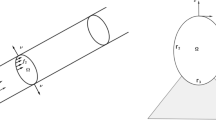Abstract
The paper provides second-order sufficient conditions for the strong local optimality of bang–bang–singular extremals in a Mayer problem with general end point constraints. The sufficient conditions are expressed as a strengthening of the necessary ones plus the coerciveness of a suitable quadratic form related to a sub-problem of the given one. The sufficiency of the given conditions is proven via Hamiltonian methods.
Similar content being viewed by others
References
Poggiolini, L., Stefani, G.: Strong local optimality for a bang-bang-singular extremal: the fixed-free case. SIAM J. Control Optim. 56(3), 2274–2294 (2018). https://doi.org/10.1137/17M1140248
Poggiolini, L., Stefani, G.: Constrained bang-bang-singular extremals. In: CDC 2019 Proceedings. IEEE (2019)
Agrachev, A.A., Sachkov, Y.L.: Control Theory from the Geometric Viewpoint. Springer, Berlin (2004)
Agrachev, A.A., Stefani, G., Zezza, P.: Strong optimality for a bang–bang trajectory. SIAM J. Control Optim. 41(4), 991–1014 (2002)
Poggiolini, L., Stefani, G.: State-local optimality of a bang-bang trajectory: a Hamiltonian approach. Syst. Control Lett. 53, 269–279 (2004)
Poggiolini, L., Spadini, M.: Strong local optimality for a bang–bang trajectory in a Mayer problem. SIAM J. Control Optim. 49(1), 140–161 (2011). https://doi.org/10.1137/090771405
Poggiolini, L., Spadini, M.: Bang–bang trajectories with a double switching time in the minimum time problem. ESAIM: COCV (2015). https://doi.org/10.1051/cocv/2015021
Stefani, G.: Strong optimality of singular trajectories. In: Ancona, F., Bressan, A., Cannarsa, P., Clarke, F., Wolenski, P. R. (eds.) Geometric Control and Nonsmooth Analysis, Series on Advances in Mathematics for Applied Sciences, vol. 76, pp. 300–326. World Scientific Publishing Co. Pte. Ltd., Hackensack (2008). Pp. 361 ISBN: 978-981-277-606-8
Poggiolini, L., Stefani, G.: Bang-singular-bang extremals: sufficient optimality conditions. J. Dyn. Control Syst. 17, 469–514 (2011). https://doi.org/10.1007/s10883-011-9127-y
Chittaro, F.C., Stefani, G.: Singular extremals in multi-input time-optimal problem: a sufficient condition. Control Cybernet. 39(4), 1029–1068 (2010)
Chittaro, F.C., Stefani, G.: Minimum-time strong optimality of a singular arc: the multi-input non involutive case. ESAIM COCV 22(3), 786–810 (2016). https://doi.org/10.1051/cocv/2015026
Agrachev, A.A., Biolo, C.: Switching in time-optimal problem with control in a ball. SIAM J. Control Optim. 56(1), 183–200 (2018). https://doi.org/10.1137/16M110304X
Agrachev, A.A., Biolo, C.: Optimality of broken extremals. J. Dyn. Control Syst. 25(2), 289–307 (2019). https://doi.org/10.1007/s10883-018-9416-9
Caillau, J.B., Orieux, M.: Sufficient conditions for time optimality of systems with control on the disk. In: CDC 2019 Proceedings. IEEE (2019)
Caillau, J.-B., Fejoz, J., Orieux, M., Roussarie, R.: Singularities of min time affine control systems. (2018). https://hal.inria.fr/hal-01718345
Maurer, H., Osmolovskii, N.: Second-order conditions for optimal control problems with mixed control-state constraints and control appearing linearly. In: 2013 IEEE 52nd Annual Conference on Decision and Control (CDC), IEEE Conference on Decision and Control, pp. 514–519 (2013)
Aronna, M.S., Bonnans, J.F., Dmitruk, A.V., Lotito, P.A.: Quadratic order conditions for bang–singular extremals. Numer. Algebra Control Optim. 2(3), 511–546 (2012). https://doi.org/10.3934/naco.2012.2.511
Bonnard, B., Caillau, J.B., Trélat, E.: Second order optimality conditions in the smooth case and applications in optimal control. ESAIM COCV 13(2), 207–236 (2007). https://doi.org/10.1051/cocv:2007012
Hilscher, R.S., Zeidan, V.: Sufficiency and sensitivity for nonlinear optimal control problems on time scales via coercivity. ESAIM COCV 24(4), 1705–1734 (2018). https://doi.org/10.1051/cocv/2017070
Vossen, G.: Switching time optimization for bang–bang and singular controls. J. Optim. Theory Appl. 144(2), 409–429 (2010). https://doi.org/10.1007/s10957-009-9594-4
Agrachev, A.A., Stefani, G., Zezza, P.: Symplectic methods for strong local optimality in the bang-bang case. In: Anzaldo-Meneses, J.G.A., Bonnard, B., Monroy-Perez, F. (eds.) Contemporary Trends in Non-linear Geometric Control Theory and Its Applications. World Scientific, London (2002)
Stefani, G., Zezza, P.: Variational Methods in Imaging and Geometric Control, chap. A Hamiltonian approach to sufficiency in optimal control with minimal regularity conditions: Part I. De Gruyter, Berlin (2016)
Agrachev, A.A., Stefani, G., Zezza, P.: An invariant second variation in optimal control. Int. J. Control 71(5), 689–715 (1998)
Stefani, G., Zezza, P.: Constrained regular LQ-control problems. SIAM J. Control Optim. 35(3), 876–900 (1997)
Hestenes, M.R.: Applications of the theory of quadratic forms in Hilbert space to calculus of variations. Pacific J. Math. 1, 525–581 (1951)
Maurer, H.: Theory and applications of bang–bang and singular control problems. In: Conference Slides (2007). 23rd IFIP TC 7 Conference on System Modelling and Optimization Kraków, Poland, July 23–27, 2007
Felgenhauer, U., Poggiolini, L., Stefani, G.: Optimality and stability result for bang-bang optimal controls with simple and double switch behaviour. Control Cybernet. 38(4B), 1305–1325 (2009)
Poggiolini, L., Stefani, G.: Structural stability for bang-singular-bang extremals in the minimum time problem. SIAM J. Control Optim. 51(5), 3511–3531 (2013). https://doi.org/10.1137/120895421
Poggiolini, L., Stefani, G.: A case study in strong optimality and structural stability of bang-singular extremals. In: Stefani, G., Boscain, U., Gauthier, J.P., Sarychev, A., Sigalotti, M. (eds.) Geometric Control Theory and Sub-Riemannian Geometry, Springer INdAM Series, vol. 5, pp. 333–350. Springer, Berlin (2014). https://doi.org/10.1007/978-3-319-02132-4_19
Poggiolini, L.: Structural stability of bang-bang trajectories with a double switching time in the minimum time problem. SIAM J. Control Optim. 55(6), 3779–3798 (2017). https://doi.org/10.1137/16M1083761
Acknowledgements
The first author acknowledges the partial support given by INDAM-GNAMPA.
Author information
Authors and Affiliations
Corresponding author
Additional information
Communicated by Aram Arutyunov.
Publisher's Note
Springer Nature remains neutral with regard to jurisdictional claims in published maps and institutional affiliations.
Appendices
Appendices
Computation of the Extended Second Variation
Problem (15) can be written as
We can allow for the controls \(\delta \upsilon _0\), \(\delta \upsilon \) to be in \(L^2 := L^2([0, T], {\mathbb {R}}) \) since equation (41) is linear with respect to the controls. Defining
we get
We aim at computing the second-order approximation \(C^{\prime \prime }\) of \(\varDelta C\).
By the properties of \(\gamma \), the constraint on \(\delta \upsilon _0\), and PMP it is not difficult to see that

Thus, the first-order approximation is null and the second-order approximation is intrinsically well defined. Obviously,
Denote as \({\mathcal {L}}^{\prime \prime }_t\) the second-order derivative of \({\mathcal {L}}_t\) at \(({\widehat{x}}_T, 0,0)\) and let \(\delta \eta \) be the linearization of \(\eta \), i.e. \(\delta \eta \) solves the problem
Hence
For the sake of computations, let us define
Let \(\varepsilon _0 := \displaystyle \int _0^{{\widehat{\tau }}_{1}}\delta \upsilon _0(s) {\text {d}}s\). Then
In particular
Define \(w(t) := \displaystyle \int _{{\widehat{\tau }}_{2}}^t - \delta \upsilon (s) {\text {d}}s\), \(\varepsilon _1 := w(T)\) and let \(\zeta :[{\widehat{\tau }}_{2}, T] \rightarrow {{\mathbb {R}}}^n\) solve the Cauchy problem
By (42), \(\zeta (T) = {\delta x}+ \varepsilon _1 f_{\mathrm{d}}({\widehat{x}}_T)\). Moreover, applying an intrinsic version of Goh transformation as in [9] we obtain
Thus
subject to
Notice that \(\delta \upsilon _0\) appears only through \(\varepsilon _0\), while the immersion
is continuous and dense. Thus we can extend \(C^{\prime \prime }\) to variations \( {\delta e}{:=} \left( {\delta x}, \delta y, \varepsilon _0, \varepsilon _1, w \right) \in {\mathcal {W}}_\mathrm{ext}\) as defined in Sect. 5, and the extension coincides with \(J_\mathrm{ext}\).
Splitting of the Second Variation
Lemma B.1
Assume \(f_{\mathrm{d}}({\widehat{x}}_T) \in T_{{\widehat{x}}_T}N_T\). Then the coerciveness of \(J_{\mathrm{ext}}\) on \({\mathcal {W}}_{\mathrm{ext}}\) splits into \( L^2_{f_{\mathrm{d}}}{\beta } \left( {{\widehat{x}}_T}\right) > 0 \) plus the coerciveness of J on \({\mathcal {W}}\).
Proof
We decompose \({\delta x}\in T_{{\widehat{x}}_T}N_T\) as \({\delta x}= \delta z+ rf_{\mathrm{d}}({\widehat{x}}_T)\), \(\delta z\in T_{{\widehat{x}}_T}\widetilde{N}_T\), where \(\widetilde{N}_T\) is the manifold defined in Sect. 5.1. We can compute
The above computation shows that the real variable r is decoupled and \(\delta z+ (r + \varepsilon _1) f_{\mathrm{d}}({\widehat{x}}_T)\) is a generic vector \({\delta x}\in T_{{\widehat{x}}_T}N_T\). This proves the claim. \(\square \)
Rights and permissions
About this article
Cite this article
Poggiolini, L., Stefani, G. Strong Local Optimality for a Bang–Bang–Singular Extremal: General Constraints. J Optim Theory Appl 186, 24–49 (2020). https://doi.org/10.1007/s10957-020-01700-2
Received:
Accepted:
Published:
Issue Date:
DOI: https://doi.org/10.1007/s10957-020-01700-2




